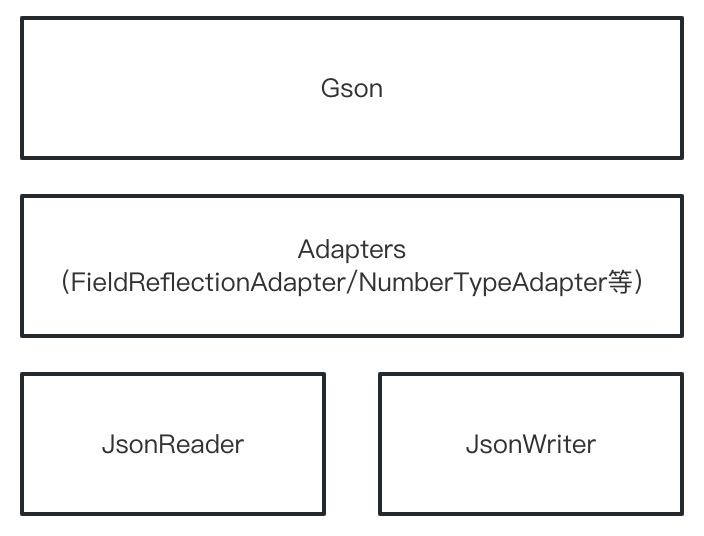java语言下,进行json处理的工具类jackson, fastjson, gson等,使用起来比较简单,就不介绍了,这次我们就来探索一下其中gson的具体实现,其核心处理类为JsonReader和JsonWriter进行json格式数据的读取和写入,上层TypeAdapter使用其进行json和具体数据类型的转换,而Gson调用时会根据类型获取到具体的TypeAdapter进行使用

在将json字符串转换成Java对象时,首先需要有定义Java的类,这里我们先不定义,而是使用一种更通用的,将json字符串转换成JsonElement的方法(com.google.gson.JsonParser#parseString)实现
1
2
3
4
5
6
7
8
9
10
11
12
13
14
15
16
17
18
19
20
21
22
23
24
25
26
27
28
29
30
31
32
33
34
35
36
37
38
39
|
public static JsonElement parseReader(JsonReader reader)
throws JsonIOException, JsonSyntaxException {
boolean lenient = reader.isLenient();
reader.setLenient(true);
try {
return Streams.parse(reader);
} catch (StackOverflowError e) {
throw new JsonParseException("Failed parsing JSON source: " + reader + " to Json", e);
} catch (OutOfMemoryError e) {
throw new JsonParseException("Failed parsing JSON source: " + reader + " to Json", e);
} finally {
reader.setLenient(lenient);
}
}
public static JsonElement parse(JsonReader reader) throws JsonParseException {
boolean isEmpty = true;
try {
reader.peek();
isEmpty = false;
return TypeAdapters.JSON_ELEMENT.read(reader);
} catch (EOFException e) {
if (isEmpty) {
return JsonNull.INSTANCE;
}
throw new JsonSyntaxException(e);
} catch (MalformedJsonException e) {
throw new JsonSyntaxException(e);
} catch (IOException e) {
throw new JsonIOException(e);
} catch (NumberFormatException e) {
throw new JsonSyntaxException(e);
}
}
|
最终调用如下Adapter
1
2
3
4
5
6
7
8
9
10
11
12
13
14
15
16
17
18
19
20
21
22
23
24
25
26
27
28
29
30
31
32
33
34
35
36
37
38
39
40
41
42
43
44
45
46
47
48
49
50
51
52
53
54
55
56
57
58
59
60
61
62
63
64
65
66
67
68
69
70
71
72
73
74
75
76
77
78
79
80
81
82
83
84
85
86
87
88
89
90
91
92
93
94
95
96
97
98
99
100
101
102
103
104
105
106
107
108
109
110
111
|
public static final TypeAdapter<JsonElement> JSON_ELEMENT = new TypeAdapter<JsonElement>() {
private JsonElement tryBeginNesting(JsonReader in, JsonToken peeked) throws IOException {
switch (peeked) {
case BEGIN_ARRAY:
in.beginArray();
return new JsonArray();
case BEGIN_OBJECT:
in.beginObject();
return new JsonObject();
default:
return null;
}
}
private JsonElement readTerminal(JsonReader in, JsonToken peeked) throws IOException {
switch (peeked) {
case STRING:
return new JsonPrimitive(in.nextString());
case NUMBER:
String number = in.nextString();
return new JsonPrimitive(new LazilyParsedNumber(number));
case BOOLEAN:
return new JsonPrimitive(in.nextBoolean());
case NULL:
in.nextNull();
return JsonNull.INSTANCE;
default:
throw new IllegalStateException("Unexpected token: " + peeked);
}
}
@Override public JsonElement read(JsonReader in) throws IOException {
if (in instanceof JsonTreeReader) {
return ((JsonTreeReader) in).nextJsonElement();
}
JsonElement current;
JsonToken peeked = in.peek();
current = tryBeginNesting(in, peeked);
if (current == null) {
return readTerminal(in, peeked);
}
Deque<JsonElement> stack = new ArrayDeque<>();
while (true) {
while (in.hasNext()) {
String name = null;
if (current instanceof JsonObject) {
name = in.nextName();
}
peeked = in.peek();
JsonElement value = tryBeginNesting(in, peeked);
boolean isNesting = value != null;
if (value == null) {
value = readTerminal(in, peeked);
}
if (current instanceof JsonArray) {
((JsonArray) current).add(value);
} else {
((JsonObject) current).add(name, value);
}
if (isNesting) {
stack.addLast(current);
current = value;
}
}
if (current instanceof JsonArray) {
in.endArray();
} else {
in.endObject();
}
if (stack.isEmpty()) {
return current;
} else {
current = stack.removeLast();
}
}
}
@Override public void write(JsonWriter out, JsonElement value) throws IOException {
}
};
|
